The Paris-Agreement-Compatible (PAC) scenario gives the recipe for the EU to do its fair share to deliver the Paris Agreement commitment to keep global temperature increase to 1.5°C. This civil-society led scenario identifies four key areas: enabling sustainable lifestyles, energy and process improvements, electrification coupled with a zero-carbon power production, and decarbonising what is left.
This second phase of the Paris Agreement Compatible (PAC) scenario charts a granular pathway for Europe to achieve net zero greenhouse gas emissions by 2040.
What would a Europe on track for 1.5°C look like?

Science is clear: the next seven years are key to deciding our fate. As the IPCC clearly indicated one more time, achieving the 1.5°C target is still possible, but governments need to act even more quickly to increase the speed and the scale of the climate action.
The emission reductions required at the EU27 are ambitious, but feasible and needed. Already by 2030, emissions must decrease by at least 63% compared to the year 2015 or 73% compared to 1990 levels, so that climate neutrality can be achieved by 2040. This means a period of less than 17 years ahead of us. A key outcome from the scenario findings is that a fast and ambitious ramp-up of both policy and behavioural measures as well as policy and market infrastructures that enable them to happen, are necessary.
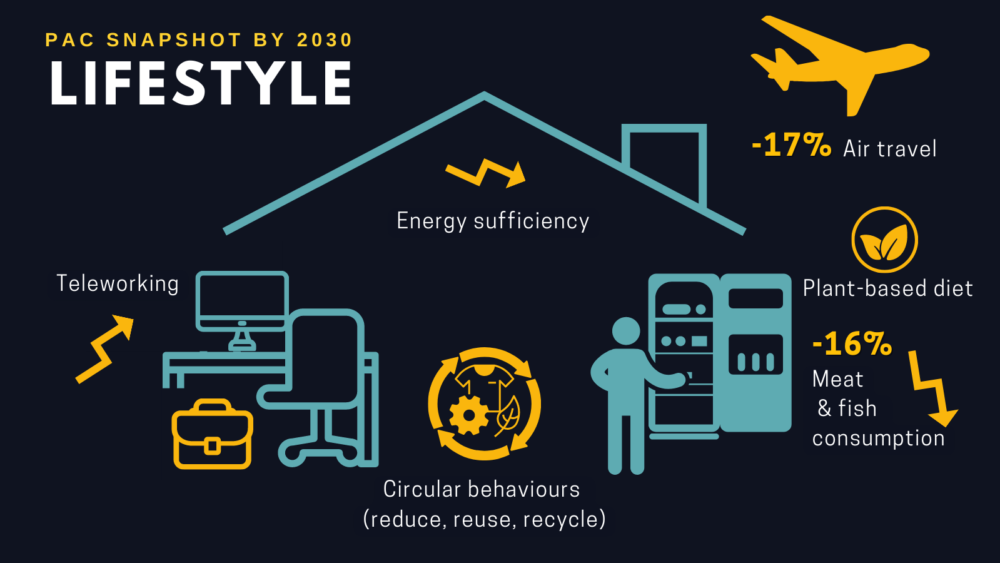
At a moment when Europe is shaken by multiple crises, our transition pathway allows us to plan for the future, and think about the EU’s resilience.
BOX 1: What is the initial PAC scenario?
The Paris Agreement Compatible (PAC) scenario, developed by CAN Europe and EEB, describes how the EU could achieve at least 65% greenhouse gas emission reductions by 2030 on a pathway towards a fully renewable energy system that achieves net zero emissions in the year 2040. It’s a science-based vision of how Europe’s energy landscape should look like, in line with the Paris Agreement and the 1.5°C threshold. An aggregated PAC scenario was created between 2018 and 2020 for the EU28 to describe an accelerated energy transition across the continent. It covers the future development of energy demand and supply until 2050 in industry, buildings, transport, and agriculture, plus a rough overview of emission reductions. That makes it an NGO benchmark for assessing the level of ambition of other EU scenarios published by different stakeholders.
BOX 2: Why a second phase of the PAC scenario building?
Following CAN Europe members’ requests, the existing aggregated PAC scenario for the EU28 from 2020 was updated for EU27, based on a more recent baseline (2015), and disaggregated to get fully-fledged country-specific PAC scenarios for EU Member States. Country-level scenarios can, for instance, challenge the weak ambition of existing National Climate and Energy Plans (NECPs) and to drive more ambition in NECP revision processes. In addition, we see the need to answer the question about how much the implementation would cost. That is why in the second phase, we will derive macro-economic indicators from the PAC scenario both on the EU and country-specific level. Last but not least, the energy infrastructure needs related to rolling out the PAC scenario will be assessed in the last quarter of 2023.
Check the Pathways Explorer for this scenario.
Buildings: high ambition level for deep renovations and sufficiency
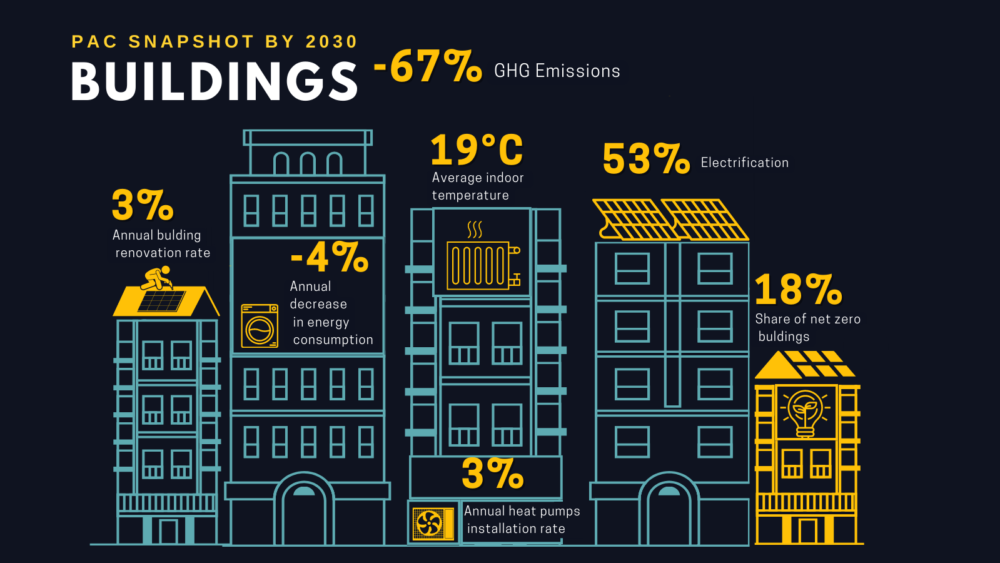
This and the next decade, almost half of buildings in Europe are expected to face renovations, and 80% of them by 2050, potentially in steps towards deep renovation, at a 3% yearly renovation rate after 2030.
By 2040, deep renovations can decrease buildings’ energy demand by more than 57% compared to a 2015 baseline, when supported by electrification, solar photovoltaics and renewable heating solutions, in other words, renewable energy based heat pumps, solar thermal and the development of district heating networks from renewable sources. This means installations of heat-pumps and solar panels at renovations, at a similar 3% rate per year.
Such measures would allow more than 40% of building stock to become ‘zero-emission buildings’, consuming on average less than 85kWh/m2 annually, using European Commission’s definitions.
This points to the immediate adoption and implementation of policies for ambitious and deep building renovations to unlock investment. At the same time, affordability considerations will be important for equity purposes. Supportive behavioural measures may include slightly lower inside temperatures at European homes, on average at 19C, and no bigger living spaces per capita than currently available.
An annual decrease of 4% of energy consumption, achieved through both efficiency and sufficiency/behavioural measures, would see a complete phase-out of fossil fuels from buildings by 2040. Buildings accounted for 15% of the total EU emissions at 485.2 MtCO2eq in 2015, and would have to see emissions drop significantly (67%) to 158.8Mt in 2030, in order for the sector to do its share in achieving climate neutrality by 2040.
Transport: electric vehicles cannot do it alone – we also need less cars
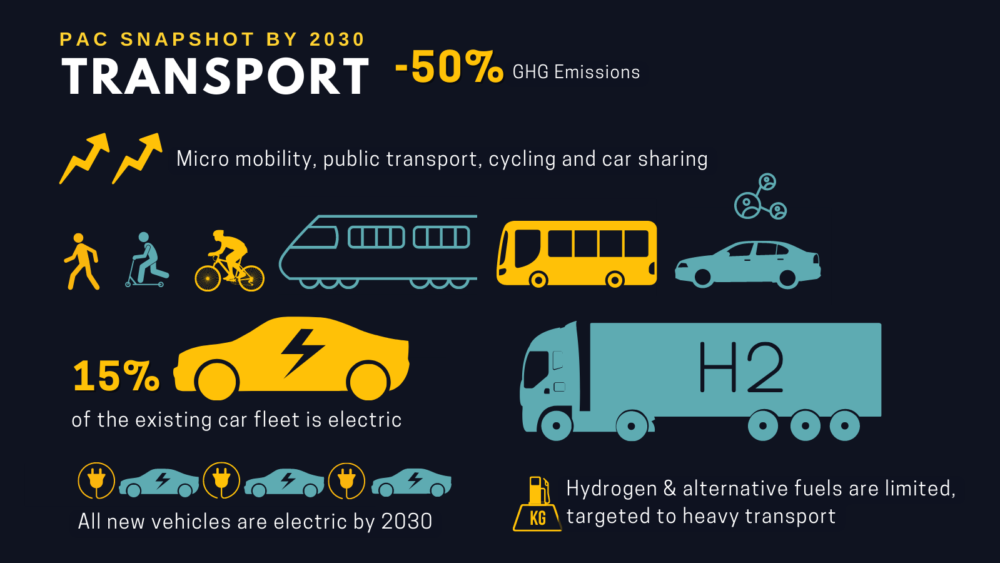
Transport is one of the hardest sectors to decarbonize.
At the baseline year 2015, transport sector emissions were at almost 800 MtCO2eq, accounting for 24% of total EU27 GHG emissions. Because of little progress, we have reached a point where transport emissions must drop each and every year by 12%, to have climate neutrality by 2040.
Active mobility, as more cycling and more walking, implies encouraging a change in modal shares, i.e. how people move. Far smarter public transport systems, and a major shift into a car-sharing economy, with shared and self-driving vehicles, could mean a dramatically smaller car fleet than what we have today.
A reduced car fleet gives more liveable and safer space for active mobility, means less pressure on road infrastructure, and reduces substantially required investments into road and transport infrastructure.
The future car fleet can use materials in a much smarter way to reduce demand on resources, helping lower industrial production levels – in line with the circular economy vision. The car of the future can be 30% more efficient in energy consumption because it is lighter, properly dimensioned, and has a more efficient drivetrain.
While the volume of the entire car fleet needs to drop substantially, the remaining must be electrified quickly – with all new vehicles being electric as of 2030. This should go in tandem with the deployment of smart and flexible EV charging infrastructure to facilitate the integration of renewable power. The use of hydrogen and alternative fuels will mainly be reserved for heavy transport.
Overall, a sharing economy and more ecological lifestyles will support the well-being of European citizens. Choosing sustainable mobility alternatives applies to air travel, and when it can be replaced, as is the case with remote conferences and teleworking. Less flying and less freight are possible, as the effects of recent crises proved. Seemingly small changes can accumulate into meaningful impacts.
As a result of these measures, in our pathway, transport emissions are more than halved already by 2030 down to 367 MtCO2eq. Ultimately, a total reduction of almost 87% of emissions would be achieved, with emissions falling down to 106 MtCO2eq in 2040.
Energy supply: renewable electrification to be fully unleashed
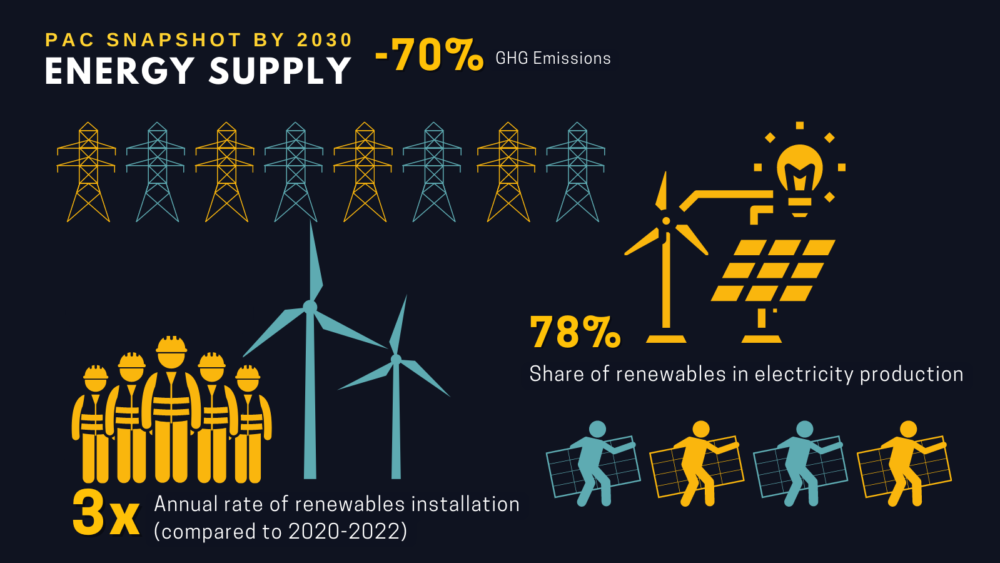
The European energy policy and markets are going through a tectonic shift, due to the impact of the recent fossil gas crisis sparked by Russia’s invasion of Ukraine. With the energy transition, the power sector is already undergoing a rapid transformation.
Our transition pathway for Europe underscores the necessity for a substantial uptake of renewables, supported by infrastructural development, to create the energy system of tomorrow. Assuming a constant rate, our results propose 105 GW of renewables to be added from 2023 onward on an annual basis. This is three times higher compared to the 2020-2022 period, when only 35GW of renewables were installed on an annual basis.
Comparing our results to the latest solar and wind industry data for 2022, at least 16% annual growth is necessary to achieve the 2030 solar target. Latest solar trends are promising. However, plans are needed to make full use of solar PV across utility-scale, commercial and residential segments. For onshore wind, at least 5-6% annual increase rate for this decade is called for. For offshore wind, at least 29% annual growth would achieve our 2030 scenario. Onshore wind capacity must be 3.5-4 times higher in 2040 than in 2022, and offshore wind must see a 15-time increase by 2040. Flexibility options, such as demand side response, storage technologies, optimised operation and extension of grids, are to be fully harnessed and actively developed. National energy actors must assume an enabling role in this.
Electrification of the processes across all sectors is necessary Europe-wide, coupled with 100% renewables based power production, and a reduction of energy demand. The PAC scenario sees an important role for renewable hydrogen but only for hard-to-decarbonise sectors, such as steel, chemicals, and fertilisers industry and certain segments of transport (most notably aviation and shipping) at the moment. To refine current estimates, in the last quarter of 2023, the PAC infrastructure analysis (PypsA modelling) will give a better view on the actual amount of hydrogen needed. In the last quarter of 2023, an infrastructure analysis of the PAC scenario will be conducted to shed light on their role in further detail.
Overall, considerable future investment into renewables can be achieved, provided that enabling market, infrastructure, regulatory and policy frameworks are in place. These frameworks must, for example, help increase installation rates and reduce permitting delays, while considering biodiversity in spatial and land-use planning. An ambitious transition means the EU must make active choices to move away from dangerous, polluting and expensive fossil fuels, phasing out coal by 2030, fossil gas by 2035 and oil by 2040 at the latest.
Our pathway is an efficient and renewable one which shows Europe can be climate-neutral in 2040, without resorting to false solutions such as nuclear energy, at a time when European countries are showing a renewed interest in its deployment.
Future industry: electrified where possible and far more circular
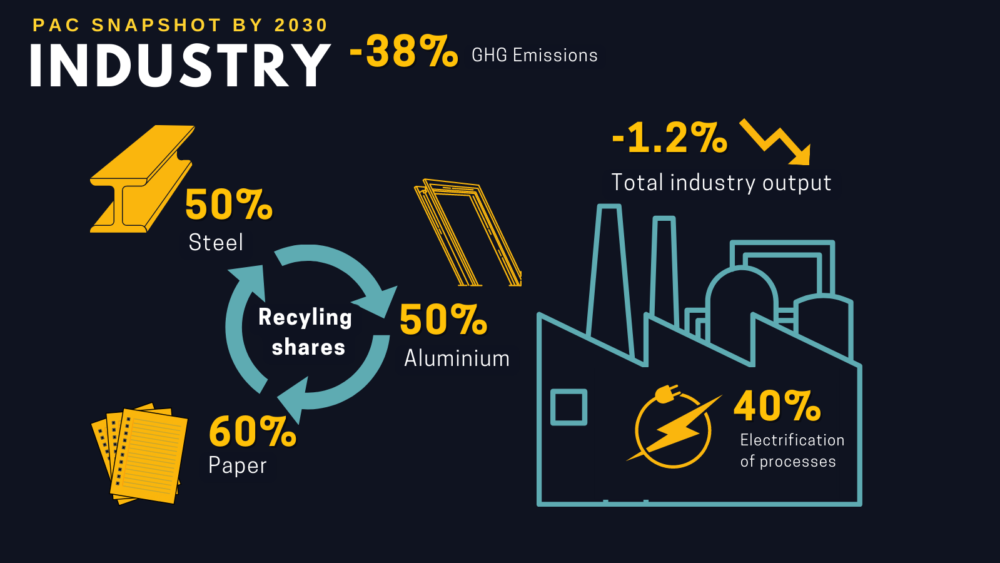
Industry will be electrified where possible, reaching 40% in 2030 and almost 57% in 2040.
Our pathway, based on a circularity approach, calls for a far more circular economy, which would impact the industry significantly. As a consequence, much higher volumes of secondary sources are used for industrial purposes. In our scenario, recycling shares at the steel industry reach 50% across the EU, almost 50% for aluminium, and 60% for the recycling of paper. Consequently, it would be possible for the total industrial output to gradually decline. It could mean 1.2% until 2030, but almost 9% by 2040.
Fewer new products and less material used per product imply lower emissions and waste costs per product. Quality, long-lasting products are of higher value, create more revenues and generate more maintenance revenue. Putting ambitious circularity into actual practice may inform firms, as they consider how to implement Environmental, Social, and Governance (ESG) and sustainability criteria even further in their actions. Understanding a changing world is also the key for industrial innovation. Elsewhere, to use the food sector as an example, consumer demand for healthier and ecological lifestyles has widened the availability of food choices, also stimulating food innovation. The same may be true for entire industries of the future, awaiting to be born.
In our transition pathway, industry greenhouse gases must reduce 38% by 2030 and more than 75% by 2040.
Related indicators: electrification of industry; GHG emission trajectory for Industry; recycling shares; total production drop 2030, 2040
BOX 3: Pathways Explorer – start to explore the European and your national pathway
An easy way to engage with this work is by using the openly available 2050 Pathways Explorer tool to explore the European climate and energy situation. Anyone can begin to explore these pathways across Europe and for their own country.
As a fully comprehensive and dynamic model, all energy sectors and greenhouse gas emissions are covered. It also assists in understanding how changes in one sector affect other sectors. For each dimension, the Pathways Explorer offers many pre-set levers, which assist the user to explore a scenario, or build their own scenario, and to see how it would develop. A set of conditions can be chosen to refine a pathway. If historical trends are a starting point, to depart from the past, as societies are already experiencing societal and technological change, one can study the differences that could result from moderate, ambitious and transformational change.
The Pathways Explorer can help in developing scenarios that are low-carbon and sustainable for a country or the whole of Europe; it can also help compare different scenarios. It may be useful to use the figures in comparison to existing energy and climate targets, such as those expressed in the National Energy and Climate Plans and in the long-term strategies, to understand what they actually mean, as concrete sectoral measures.
The way forward
Another novelty of the PAC process are forthcoming national scenarios, which disaggregate the analysis to national-level across 27 EU Member States.
Further work on country insights will inform shaping and strengthening of National Energy and Climate Plans ahead of a EU-wide revision process due to start this year to align with the Paris Agreement’s objectives for an energy transition that is #FitFor1point5. Building on the scenario work, forthcoming steps this year will include considerations of socio-economic aspects as well as infrastructural analysis.
A fast achievement of climate neutrality would make a substantial contribution to validate the EU’s claims as a climate leader, bearing in mind discussions on a fair and ambitious share of its global carbon budget.


